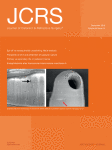JCRS highlights selected by Professor Thomas Kohnen
Vol: 44 Issue: 12 December 2018

Thomas Kohnen
Published: Friday, February 1, 2019
 JCRS December 2018
JCRS December 2018Vol: 44 Issue: 12 December 2018

Published: Friday, February 1, 2019
 JCRS December 2018
JCRS December 2018